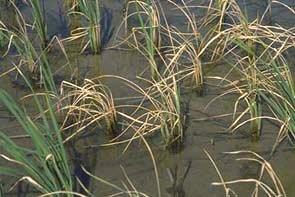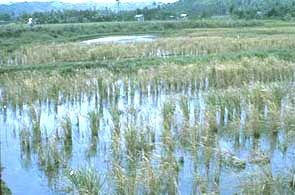
|
|
Stress Management :: Salinity |
|
Effect salt stress on crop growth and development Two major effects of salinity on crop plants 1. Osmotic effect or water deficit effect Reduces the plant’s ability to take up water, and this leads to slower growth. This is the osmotic or water-deficit effectof salinity. 2. Salt specific effect or Ion Excess Effect Salts enter the transpiration stream and eventually injure cells in the transpiring leaves, further reducing growth Effect of salt stress on crop growth and development1. Germination Seed germination in saline condition is affected by three ways. Increased osmotic pressure of the soil solution which restricts the absorption and entry of water into the seeds. Certain salt constituents are toxic to the embryo and seedlings. Anions like CO3, NO3, Cl-, SO4 are more harmful to seed germination. Salt stress hampers the metabolism of stored materials. Protease, enzyme catalyses the solubility of proteins to soluble nitrogen in seeds is inhibited by salinity. a - amylase activity is very much inhibited. Therefore starch to sugar conversion is prevented. Salinity delays the synthesis of nucleic acids and RNAase. Salinity exerts an inhibition of glyoxysomal catalase, malate synthase and isocitrate lyase leads to reduction of glycerides and more of free fatty acids in oil seeds. 2. Vegetative growthDue to accumulation of more ions in the soil as well as in the root zone, plants are unable to absorb water and thus water deficit stress condition is occurred in plants, which is termed as physiological drought. During vegetative stage, salt induced water stress causes closure of stomata leads to reduction in CO2 assimilation and transpiration. Reduced turgor potential affects the leaf expansion. Because of reduction in leaf area, light interception is reduced, photosynthetic rate is affected which coupled with spurt in respiration, resulting into reduced biomass accumulation.
3. Photosynthetic Accumulation of high concentration of Na2 and Cl- in chloroplast, photosynthesis is inhibited. Since photosynthetic electron transport appears relatively insensitive to salts, either carbon metabolism or photophosphorylation may be affected. Photosynthetic enzyme or the enzymes responsible for carbon assimilation are very sensitive to the presence of NaCl. 4. Reproductive growth and yield Under salt stress condition, the onset of flowing is delayed due to the limitations of source size. The quantum of reproductive structure such as number of flowers / panicle is very much reduced. Due to high deposition of salts in tissues, most of the metabolic processes such as synthesis of proteins, amino acids, sugars, starch and other organic compounds are altered. This disturbance in the normal metabolism affects the mobility of metabolites from the site of production to the site of utilization for reproductive growth. Therefore the development of reproductive structures and further maturation processes are very much affected which ultimately diminish the crop yield. Due to imbalance of nutrients under salt stress, hormone synthesis is hampered leads to reduction in quantity as well as quality of crop produce.
CROP ADAPTATIONS TO SALT STRESSBased on the responses to high concentration of salts, plants can be divided into two broad groups. 1) Halophytes HalophyteGroup of plants able to grow even in high saline conditions, which are otherwise called as salt tolerant types. They are native to saline soils. Glycophytes (Literally "sweet plants") NonhalophytesThey are sensitive plants and unable to grow under saline conditions. Most of the cultivated crop species belong to glycophytes. Glycophytes begin to show the signs of growth inhibition, leaf discoloration and loss of dry weight, when concentration of the salts reaches above the threshold level. Among the crops, maize, onion, citric lettuce and bean are highly sensitive to salt. Cotton and barley are moderately sensitive sugarbeet and date palms are highly tolerant. |
|
| © All Rights Reserved. TNAU-2016. |
|

